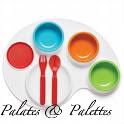Artist's Paint Brushes Buying Guide
 Painting is a skill much like any other; it requires special tools to accomplish the job correctly. Essentially, paint brushes
Painting is a skill much like any other; it requires special tools to accomplish the job correctly. Essentially, paint brushes
Natural vs. Synthetic Brushes
The major difference that divides synthetics
- Synthetics -- Cheaper. For use with acrylics
. - Synthetics are not good for use with oil paints since cleaning them requires cleaning with turpentine, which will destroy them.
- They don't depend on a fluctuating market, rising or falling animal populations, or other environmental factors that might affect animal fur and the cost of it. Synthetics pose no moral dilemma for vegans or vegetarians either.
- Because synthetics are less porous than natural hair, they are more versatile for using with different mediums and on different surfaces.
- Built to be strong and durable.
- Natural -- Best for use with oils
- Natural brushes don't hold up well to acrylics since the chemicals eat away at the natural oils in the bristles.
- Many brushes contain blends of two or more of the different types of hairs mentioned below.
- Soft bristles -- Kolinsky sable (highest quality), badger, ox/sabeline, squirrel, goat, and pony.
- Camel -- This is often a blend of other natural hairs, not hair from a camel. The best ones utilize the natural tip of the hair, not one that has been previously cut. For example, a camel brush made primarily of pony hair will most likely be using hair from the mane, which receives multiple cuts to yield more brushes. This is the lowest quality of natural brushes.
- Hard bristles -- Boar, hog, or pig.
Brush Shapes
 |  |  |  |  |
| Makes pointed, thin lines at the tip or wide strokes when pressed down. Use for details, pointed lines, washes, and fills. Choose a pointed round for more ability to paint details. | Depending on the size, flats (aka shaders) can be used for big washes, blocks, and fills or fine lines when angled on its side. Good for all types of mediums. | | Basically, these are very long round, pointed brushes used for detailing and outlining with fine, long, continuous lines. Also used for lettering. Good with all paint types. | These are essentially flats, but shorter, stiffer, and not particularly good for watercolors. Excellent for short strokes. Also called a chisel blender. |
 |  |  |  |  |
| Fan brushes are very versatile. They can blend, be used dry, or they can be loaded heavy with paint to create texture. Not for watercolors. | Great for most things, except oil painting. Similar to a flat brush, and can create details, tight shading, or more general blocks of color. | Usually made with natural hair, making them excellent for watercolor, washes, and blending. They also mop up extra water on the canvas. | Spotters are short bristled brushes with a fine point. They are ideal for adding details and lines. | These are exclusively used for doing watercolors and they often have natural hairs, best for absorbing water. |
Sizing
Besides the shape of the brush, you'll also want to choose the appropriate size. This is largely determined by the size of the canvas that you are working on, as well as the amount of detail that you are working with. Sizing, which has no overall industry standard, is measured roughly like so:
- Smallest Brushes (Liners) -- 10/0 | 7/0 | 6/0 | 5/0 | 4/0
- Small Brushes (Liners) -- 000 | 00 | 0 | 1-5
- Medium Brushes -- 6-14
- Large Brushes -- 15-20
- Largest Brushes -- 21-30
What do the numbers really mean? To get an idea of the sizes of these brushes, know that a size 12 is equal to a 12mm wide head. Therefore, a size 6 would be a 6 mm head, a size 1, a 1mm head, and so on. Numbers smaller than 1, such as 10/0 mean that the brush is 10 units less than a mm.
Ferrules
This is the metallic band that wraps around the head and the handle of the brush. It can be made of various materials, including seamless copper and nickel, and spot-welded, nickel-plated steel. The latter is rust resistant.
Cleaning and Usage Tips
- Usage -- Be aware that you need to have different brushes for each type of painting you plan to undergo since the bristles are designed differently for each type of paint. Keep your acrylic brushes separate from the oil brushes, and keep the watercolors separate from those. Otherwise, if you mix them, it will compromise the longevity of the brush bristles.
- Never leave brushes standing in water, except for rinsing and washing, since it will deform the bristles.
- Don't press or push the bristles so that they spread on the canvas; it will destroy the head's shape.
- Over time, a paint brush head will naturally become worn down and it may become stained.
- Cleaning -- After painting, it is extremely important that you wash your brushes as soon as possible.
- First wipe them off with a cloth or paper towel. Then rinse them. Acrylics should be rinsed in lukewarm (NEVER hot since it will cause the bristles to fall out and it will strip the natural oils from the bristles) and oils will need turpentine or another solvent.
- Once the majority of the paint has been removed, wipe the brushes down again and wash them with a gentle bar soap, working the bristles gently in the palm of your hand. Rinse the brushes with water until the water runs clear.
- Shake off excess water and wrap in a towel or paper towel to reshape the head and to let dry.
- Storage -- Always store brushes upright so that the head does not become damaged.













0 comments:
Post a Comment